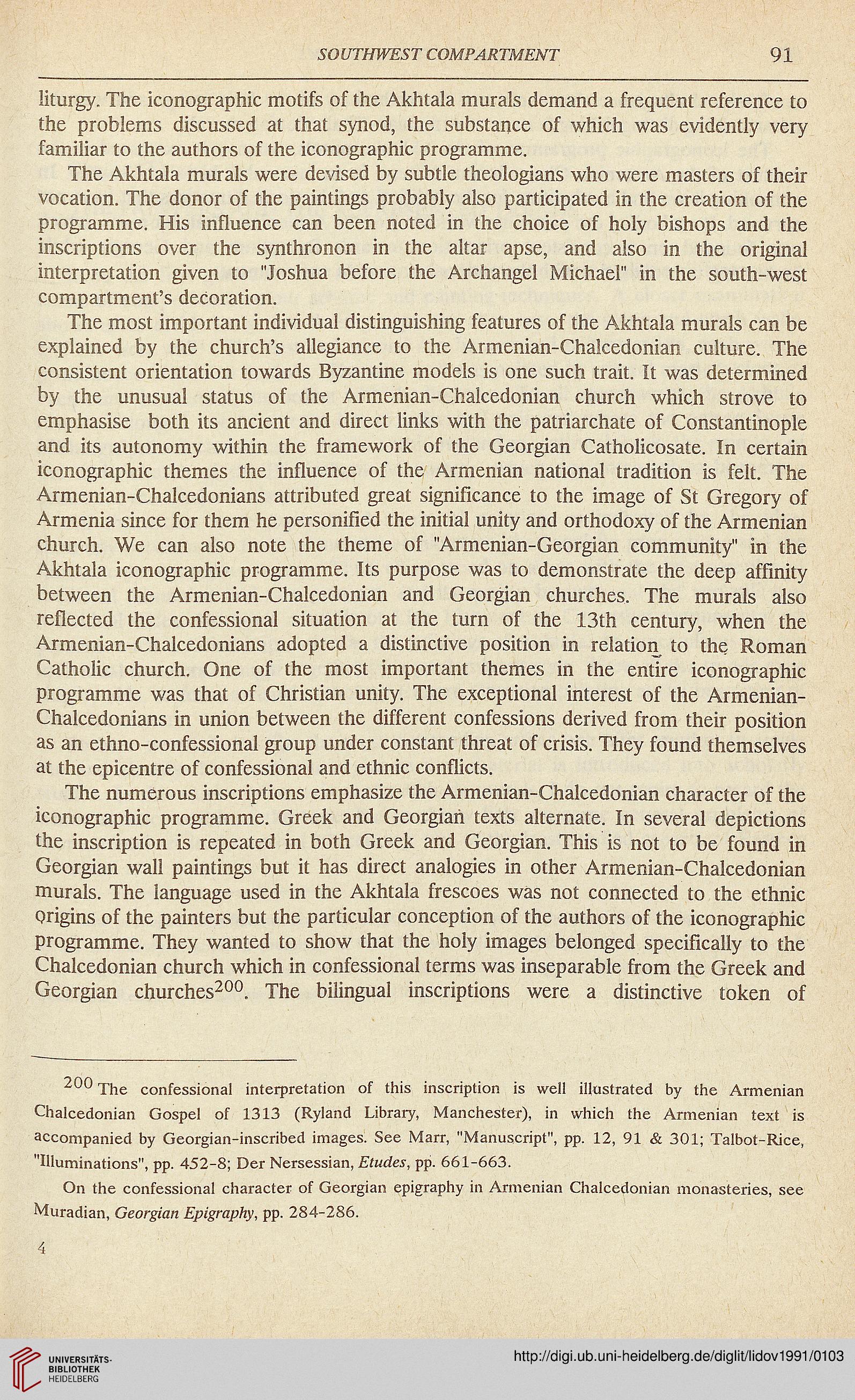30t/77WE3r COMR-l/G'MEAT
91
liturgy. The iconographic motifs of the Akhtaia murais demand a frequent reference to
the probiems discussed at that synod, the substance of which was evidentiy very
familiar to the authors of the iconographic programme.
The Akhtaia murals were devised by subtle theologians who were masters of their
vocation. The donor of the paintings probably also participated in the creation of the
programme. His influence can been noted in the choice of holy bishops and the
inscriptions over the synthronon in the altar apse, and also in the original
interpretation given to "Joshua before the Archangel Michael" in the south-west
compartment's decoration.
The most important individual distinguishing features of the Akhtaia murals can be
explained by the church's allegiance to the Armenian-Chalcedonian culture. The
consistent orientation towards Byzantine models is one such trait. It was determined
by the unusual status of the Armenian-Chalcedonian church which strove to
emphasise both its ancient and direct links with the patriarchate of Constantinople
and its autonomy within the framework of the Georgian Catholicosate. In certain
iconographic themes the influence of the Armenian national tradition is felt. The
Armenian-Chalcedonians attributed great significance to the image of St Gregory of
Armenia since for them he personified the initial unity and orthodoxy of the Armenian
church. We can also note the theme of ' Armenian-Georgian community" in the
Akhtaia iconographic programme. Its purpose was to demonstrate the deep affinity
between the Armenian-Chalcedonian and Georgian churches. The murals also
reflected the confessional situation at the turn of the 13th century, when the
Armenian-Chalcedonians adopted a distinctive position in relation to the Roman
Catholic church. One of the most important themes in the entire iconographic
programme was that of Christian unity. The exceptional interest of the Armenian-
Chalcedonians in union between the different confessions derived from their position
as an ethno-confessional group under constant threat of crisis. They found themselves
at the epicentre of confessional and ethnic conflicts.
The numerous inscriptions emphasize the Armenian-Chalcedonian character of the
iconographic programme. Greek and Georgian texts alternate. In several depictions
the inscription is repeated in both Greek and Georgian. This is not to be found in
Georgian wall paintings but it has direct analogies in other Armenian-Chalcedonian
murals. The language used in the Akhtaia frescoes was not connected to the ethnic
Origins of the painters but the particular conception of the authors of the iconographic
programme. They wanted to show that the holy images belonged specifically to the
Chalcedonian church which in confessional terms was inseparable from the Greek and
Georgian churches^. The bilingual inscriptions were a distinctive token of
200 The confessions] interpretation of this inscription is weH iilustrated by the Armenian
Chalcedonian Gospe) of 1313 (Rytand Library, Manchester), in which the Armenian text is
accompanied by Georgian-inscribed images. See Marr, "Manuscript", pp. 12, 91 & 301; Tatbot-Rice,
"illuminations", pp. 432-8; Der Nersessian, Etader, pp. 661-663.
On the confessions) character of Georgian epigraphy in Armenian Chalcedonian monasteries, see
Muradian, Georgia/; .Epigraphy, pp. 284-286.
4
91
liturgy. The iconographic motifs of the Akhtaia murais demand a frequent reference to
the probiems discussed at that synod, the substance of which was evidentiy very
familiar to the authors of the iconographic programme.
The Akhtaia murals were devised by subtle theologians who were masters of their
vocation. The donor of the paintings probably also participated in the creation of the
programme. His influence can been noted in the choice of holy bishops and the
inscriptions over the synthronon in the altar apse, and also in the original
interpretation given to "Joshua before the Archangel Michael" in the south-west
compartment's decoration.
The most important individual distinguishing features of the Akhtaia murals can be
explained by the church's allegiance to the Armenian-Chalcedonian culture. The
consistent orientation towards Byzantine models is one such trait. It was determined
by the unusual status of the Armenian-Chalcedonian church which strove to
emphasise both its ancient and direct links with the patriarchate of Constantinople
and its autonomy within the framework of the Georgian Catholicosate. In certain
iconographic themes the influence of the Armenian national tradition is felt. The
Armenian-Chalcedonians attributed great significance to the image of St Gregory of
Armenia since for them he personified the initial unity and orthodoxy of the Armenian
church. We can also note the theme of ' Armenian-Georgian community" in the
Akhtaia iconographic programme. Its purpose was to demonstrate the deep affinity
between the Armenian-Chalcedonian and Georgian churches. The murals also
reflected the confessional situation at the turn of the 13th century, when the
Armenian-Chalcedonians adopted a distinctive position in relation to the Roman
Catholic church. One of the most important themes in the entire iconographic
programme was that of Christian unity. The exceptional interest of the Armenian-
Chalcedonians in union between the different confessions derived from their position
as an ethno-confessional group under constant threat of crisis. They found themselves
at the epicentre of confessional and ethnic conflicts.
The numerous inscriptions emphasize the Armenian-Chalcedonian character of the
iconographic programme. Greek and Georgian texts alternate. In several depictions
the inscription is repeated in both Greek and Georgian. This is not to be found in
Georgian wall paintings but it has direct analogies in other Armenian-Chalcedonian
murals. The language used in the Akhtaia frescoes was not connected to the ethnic
Origins of the painters but the particular conception of the authors of the iconographic
programme. They wanted to show that the holy images belonged specifically to the
Chalcedonian church which in confessional terms was inseparable from the Greek and
Georgian churches^. The bilingual inscriptions were a distinctive token of
200 The confessions] interpretation of this inscription is weH iilustrated by the Armenian
Chalcedonian Gospe) of 1313 (Rytand Library, Manchester), in which the Armenian text is
accompanied by Georgian-inscribed images. See Marr, "Manuscript", pp. 12, 91 & 301; Tatbot-Rice,
"illuminations", pp. 432-8; Der Nersessian, Etader, pp. 661-663.
On the confessions) character of Georgian epigraphy in Armenian Chalcedonian monasteries, see
Muradian, Georgia/; .Epigraphy, pp. 284-286.
4




